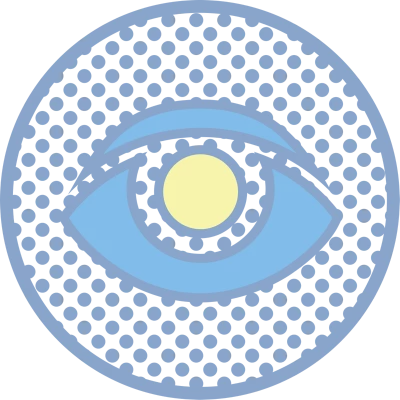Understanding Blue Dot Cataract: Causes, Symptoms, and Treatment
Blue dot cataract is a rare form of cataract in which the lens of the eye becomes opaque due to a genetic mutation. Although most people associate the occurrence of cataracts with ageing or injuries, blue dot cataracts fall into the category of congenital cataracts.
The presence of small, blue or greyish-coloured dots or flecks characterises them. Most of the time, such dots do not impede vision. However, they contribute to the slight blurring of sight.
This blog will explore the definition of blue dot cataract, causes and symptoms, diagnosis, treatment, representative ideas, and when to see an eye specialist.
What Is a Blue Dot Cataract?
Blue dot cataract: A pinhead-sized, bluish-grey cloud or point in the lens, typically congenital. Blue dot cataract, unlike traumatic cataract, does not develop overnight as a result of an eye injury.
It occurs as a result of an alteration in the protein content found in the lens, which diffracts light, hence leading to the characteristic appearance of a blue spot in the eye. This type of cataract is generally discovered during a routine eye check-up.

Causes of Blue Dot Cataract
Blue dot cataracts are usually inherited. Here are some of the common causes of blue dot cataract:
Genetic Mutations
Blue dot cataracts develop as a result of alterations in the genes that produce the lens protein. The misfolding of the protein causes the crystalline material to accumulate, resulting in opacity and a pale, bluish colour.
Autosomal Dominant Inheritance
The blue dot cataracts are often autosomal dominant. That is, only one copy of the defective gene of either parent can lead to the condition. Therefore, there is a high likelihood of a family history.
Specific Genes
Some identified genes include those in lens crystallin families (CRYAA, CRYAB). Mutations disrupt normal protein stability and lens stability and transparency, producing the blue ‘dot’.
Visual Impact
Although it is named a cataract, the blue dot cataract has a minor impact on vision, but its existence is associated with alterations in lens clarity and may slowly worsen, likely to gradually improve along with other types of cataract.
Symptoms of Blue Dot Cataract
Many people deal with blue dot cataract and may experience:
Blurry or Dim Vision
The dotted opacity can cause the vision to be slightly blurred or even dimmed, especially along central sight lines, as a result of light scattering.
Increased Light Sensitivity
Lens diffusion sensitises the eye to bright light, making environments like sunlit rooms uncomfortable and challenging during outdoor activities.
Halos Around Lights
Patients often report glare or halo effects around lights at night, which is caused by light scattering within the lens.
Difficulty Seeing at Night
Driving and other tasks carried out, especially at night, may be more challenging due to decreased contrast and glare, which can be hazardous.
Fading Colours
Lens opacity may reduce contrast and colour vibrancy, making everyday objects appear duller.
Double Vision
More than one path of light through a lens opacification may result in mild diplopia (double vision) in one eye, especially under bright lighting conditions.

How to Prevent Blue Dot Cataract?
Though genetic inheritance can’t be prevented, lifestyle strategies help delay progression or minimise other cataract risks:
- Protect eyes with UV-blocking sunglasses.
- Quit smoking and reduce alcohol use.
- Maintain good blood sugar control in individuals with diabetes.
- Eat antioxidant-rich foods such as leafy greens and fish.
- Schedule annual or biennial eye tests, especially if there’s a family history, any history of trauma, or existing early lens changes.
Staying vigilant helps detect changes promptly and preserves vision quality.
Diagnosing Blue Dot Cataract
A comprehensive diagnosis involves a combination of clinical examination and, in some cases, genetic testing.
Slit-Lamp Examination
This is the most reliable method for detecting blue dot cataracts. Under high magnification and illumination, an ophthalmologist can visualise the distinctive bluish lens opacity and assess its size and location.
Visual Acuity Test
Using standard eye test charts, doctors assess how well each eye functions. Any decline or difference between eyes may signal early lens opacity.
Retinal Examination
A dilated fundus exam ensures that no underlying retinal disease is present. It helps differentiate what’s contributing to visual disturbances.
Genetic Testing
Where appropriate, genetic analysis can identify known mutations linked to blue dot cataract. This is essential if there’s family history or concerns about hereditary risk.
Treatment Options for Blue Dot Cataract
Cataract Surgery
The most common treatment for blue dot cataract is lens extraction once it starts affecting vision or daily life operations. The opaque lens is removed, and a transparent intraocular lens (IOL) is inserted. Modern cataract treatment is safe and effective, with a quick recovery and minimal pain.
Living with Blue Dot Cataract
If the opacity is minor, you may manage daily tasks with:
- Prescription glasses or contact lenses to correct minor visual changes.
- Anti‑glare lenses for driving at night.
- Regular check‑ups to monitor stability.
Early cataract doesn’t always necessitate immediate surgery. It may be managed conservatively until vision warrants treatment.
When to See an Eye Doctor for Blue Dot Cataract
If you experience persistent symptoms, such as blurred vision, double vision, or difficulty in bright light, a medical evaluation is warranted. Also, consider early consultation if:
- Cataract interferes with daily activities (reading, driving).
- You experience sudden or progressive changes in your vision.
- Family members have a cataract history.
- You are preparing for a comprehensive eye test.
Timely care ensures optimal outcomes and the earliest opportunity for treatment when necessary.
Conclusion
Blue dot cataract is a distinct form of lens opacity with genetic origins. It typically presents with a blue‑grey spot in the lens and may cause visual symptoms such as glare, dimmed vision, or occasional double vision. Diagnosis is based on clinical examination, including slit-lamp and acuity tests, and may also involve genetic confirmation.
Treatment primarily involves cataract surgery when the cataract begins to affect vision. Living with this condition requires monitoring and collaboration with your eye care provider. Preventive measures, including wearing sunglasses, adopting a healthy lifestyle, and undergoing routine eye tests, help preserve vision and delay its progression.
In case of any symptoms of the blue dot cataract or doubts about the genetic risk of the condition, make an appointment at Dr Agarwals Eye Hospital to undergo a complete assessment of your lens. An early diagnosis or intervention can save your vision and quality of life.
Frequently Asked Questions (FAQs) about Blue Dot Cataract
Are Blue Dot Cataracts Common in Older Adults?
Blue dot cataracts are, in most instances, hereditary and typically occur in children or young individuals. Unlike nuclear or cortical cataracts, they are not regarded as an age-related disorder among older people. However, in the case of non-diagnosis earlier, they might stabilise or gradually (but not significantly) develop throughout the stages of later adulthood.
How Does Blue Dot Cataract Affect Daily Activities?
The visual effects of blue dot cataracts are not significant until later in life. Still, the condition can inhibit activities that require sharp focus, such as reading or driving at night, because light is being diffused. Depending on the patient, there is a certain possibility of glare, eye strain, or difficulty identifying details, which can be a factor affecting productivity and quality of life.
What Are the Long-Term Effects of Blue Dot Cataracts on Vision?
Blue dot cataracts are stable and small, and may not have a significant impact on vision. However, some progressive cases may progressively diminish the levels of clarity, contrast sensitivity, and colour perception. Without early treatment, children may experience long-term consequences, including amblyopia or an inability to perceive depth due to decreased visual development at a young age.
Can Blue Dot Cataract Occur in Both Eyes Simultaneously?
Yes, blue dot cataracts can affect both eyes, especially when the cause is a genetic mutation. The inherited cases tend to be bilateral. Nonetheless, it can be severe in one eye, while being normal in the other. Frequent assessment and visual tests are crucial in determining when surgery is necessary to achieve optimal vision.
How Long Does Recovery Take After Blue Dot Cataract Surgery?
The blue dot cataract surgery recovery typically occurs quickly, and most patients regain functional vision within 24-72 hours. Recovery and adaptation to the insertion of intraocular lenses may take up to weeks. To achieve healing, patients are expected to adhere to post-operative guidelines and attend follow-up sessions to determine if any complications arise.
This information is for general awareness only and cannot be construed as medical advice. Recovery Timelines, specialist availability, and treatment prices may vary. Please consult our specialists or visit your nearest branch for more details.Insurance coverage and associated costs may vary depending on the treatment and the specific inclusions under your policy. Please visit the insurance desk at your nearest branch for detailed information.

Do not ignore eye trouble!
Now you can reach our senior doctors by booking an online video consultation or a hospital appointment
Book an appointment now
